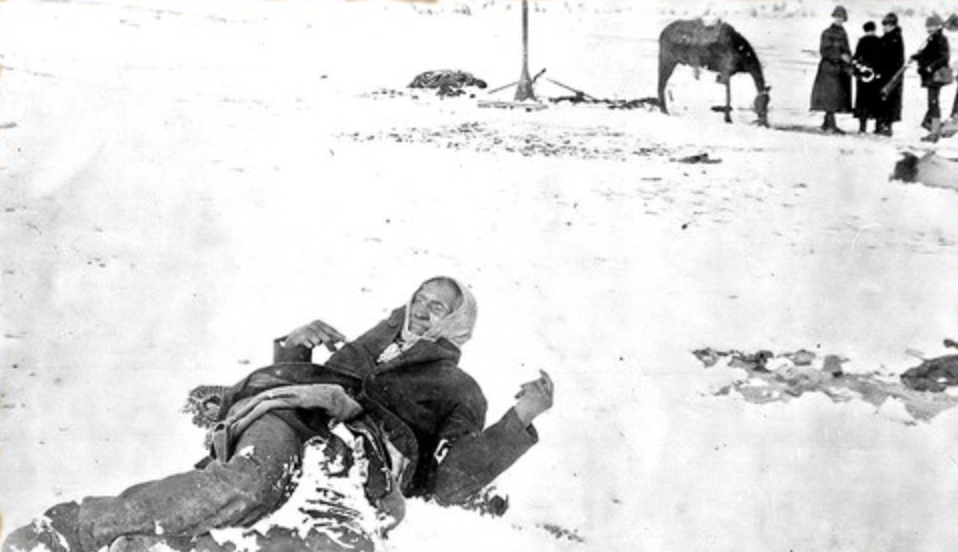
- Details
- By Levi Rickert
Opinion. Today, we remember the one hundred and thirty-three winters ago, on December 29, 1890, when innocent Lakota men, women, and children were massacred by the U.S. 7th Cavalry Regiment near Wounded Knee Creek on the Pine Ridge Indian Reservation. Some estimates place the death toll close to 300, underscoring the horrific scale of this tragedy.
The massacre occurred under the pretense of disarming the Lakota, who had already suffered profound losses due to U.S. policies, broken treaties, and forced relocations. That December, the Great Plains were covered in heavy snowfall, adding to the grim and unforgiving conditions. The Lakota ancestors who were killed were left lying in the brutal, frigid environment of the reservation until a burial party arrived days later to place their frozen bodies in a mass grave.
A haunting photograph of Chief Big Foot’s frozen and contorted body has since become a powerful symbol for American Indians, a stark reminder of the atrocities endured by their ancestors.
Some survivors of the massacre were taken to the Episcopal mission in Pine Ridge, where they received care. In time, they shared oral histories of the events that unfolded that day, passing down the stories of their trauma and resilience to future generations. These accounts form the foundation of our understanding of what happened, preserving the memory of those who suffered and died.
One poignant detail from that dark chapter in American history has remained etched in my mind since I first read these words from Dee Brown’s Bury My Heart at Wounded Knee: “It was the fourth day after Christmas in the Year of our Lord 1890, when the first torn and bleeding bodies were carried into the candlelit church. Those who were conscious could see Christmas greenery hanging from the open rafters. Across the chancel front above the pulpit was strung a crudely lettered banner: Peace on Earth, Good Will to Men.”
There was no peace on earth for the Lakota that day. Instead, there was unimaginable violence and suffering, compounded by the bitter irony of that banner hanging above the pulpit. It stands as a chilling reminder of the cruelty and Christian hypocrisy faced by Indigenous peoples during this era.
Adding insult to injury, some 20 U.S. Cavalry soldiers were awarded Medals of Honor for their actions during the massacre. These commendations, meant to recognize acts of heroism, instead glorified the slaughter of innocent Lakota men, women, and children. This grotesque distortion of justice is an affront to the memory of those who perished and to humanity itself.
Today, there is a growing movement to rectify this historical wrong. The “Remove the Stain Act,” that lingers in Congress, aims to strip those soldiers of their Medals of Honor, a long-overdue step toward acknowledging the truth of what happened at Wounded Knee. Passing this legislation would be a meaningful act of justice, albeit symbolic, for the Lakota people and all American Indians.
The Wounded Knee Massacre is not only a historical tragedy but also a symbol for all American Indians of the injustices inflicted upon their ancestors. It marks the end of the American Indian Wars, yet it also signifies a moment when Indigenous peoples were largely erased from mainstream American history. After Wounded Knee, many history books fell silent about the continued struggles and resilience of Native peoples, as if they no longer existed.
But we do exist. Native Americans have endured and persevered for generations since Wounded Knee. Despite the systemic efforts to erase our culture, language, and identity, we have survived. It is our responsibility as descendants to honor our ancestors by remembering their sacrifices and by building a better future for ourselves and the generations to come. We are taught to prepare for the next seven generations, ensuring that their lives are enriched by the lessons of the past and the resilience of our people.
As we work toward a brighter future, we must never forget the ancestors we lost 132 winters ago on December 29, 1890. Their memory fuels our determination to preserve our culture, advocate for justice, and ensure that the stories of our people are never forgotten. By remembering Wounded Knee, we honor their lives and reaffirm our commitment to a legacy of strength, survival, and hope.
Thayék gde nwéndëmen - We are all related.
More Stories Like This
Tribes Do Not Need a Greenlight to Build Renewable EnergyLaw Should Not Get in the Way When "Manifest-ing Destiny"
Celebrating 35 Years of Gaming Success
My Tribe’s ICE Contract Betrayed Our Values
Extending the Affordable Care Act Is a Moral Imperative for Indian Country
Help us defend tribal sovereignty.
At Native News Online, our mission is rooted in telling the stories that strengthen sovereignty and uplift Indigenous voices — not just at year’s end, but every single day.
Because of your generosity last year, we were able to keep our reporters on the ground in tribal communities, at national gatherings and in the halls of Congress — covering the issues that matter most to Indian Country: sovereignty, culture, education, health and economic opportunity.
That support sustained us through a tough year in 2025. Now, as we look to the year ahead, we need your help right now to ensure warrior journalism remains strong — reporting that defends tribal sovereignty, amplifies Native truth, and holds power accountable.
 The stakes couldn't be higher. Your support keeps Native voices heard, Native stories told and Native sovereignty defended.
The stakes couldn't be higher. Your support keeps Native voices heard, Native stories told and Native sovereignty defended.
Stand with Warrior Journalism today.
Levi Rickert (Potawatomi), Editor & Publisher


